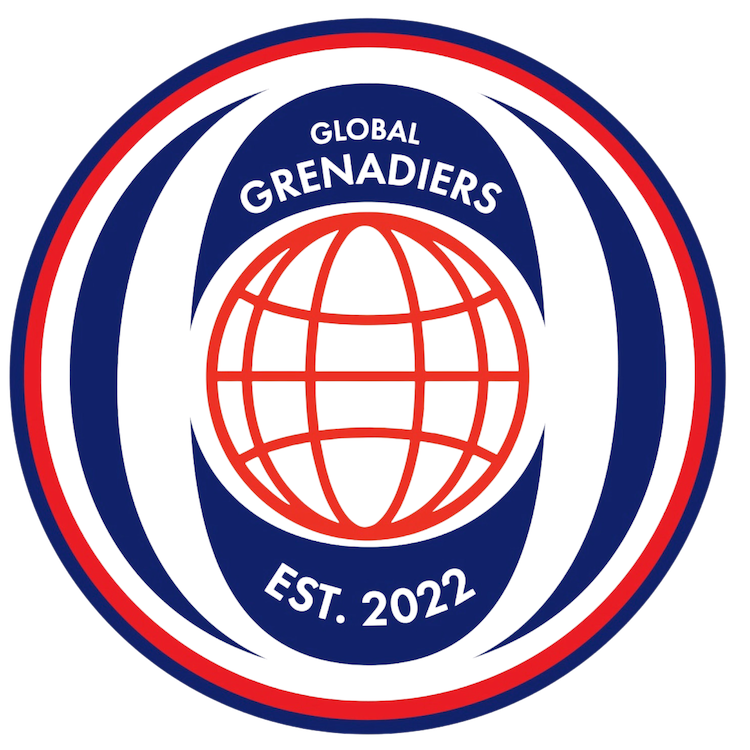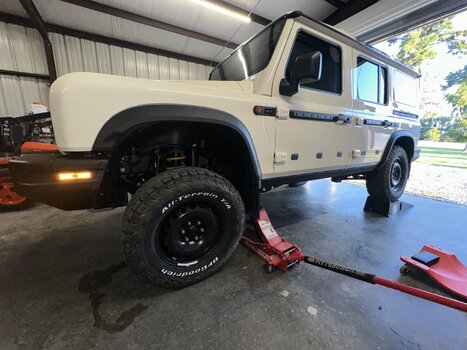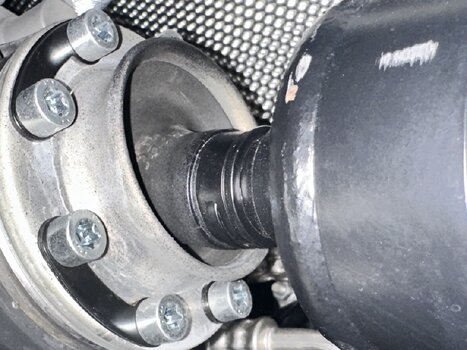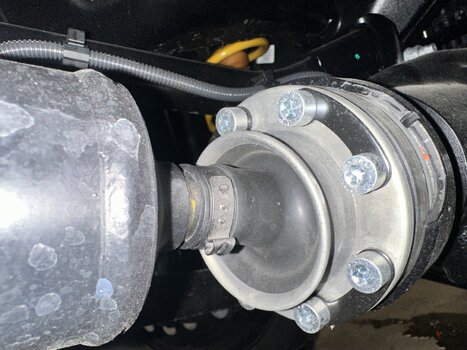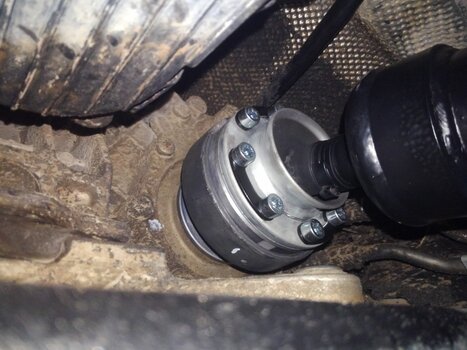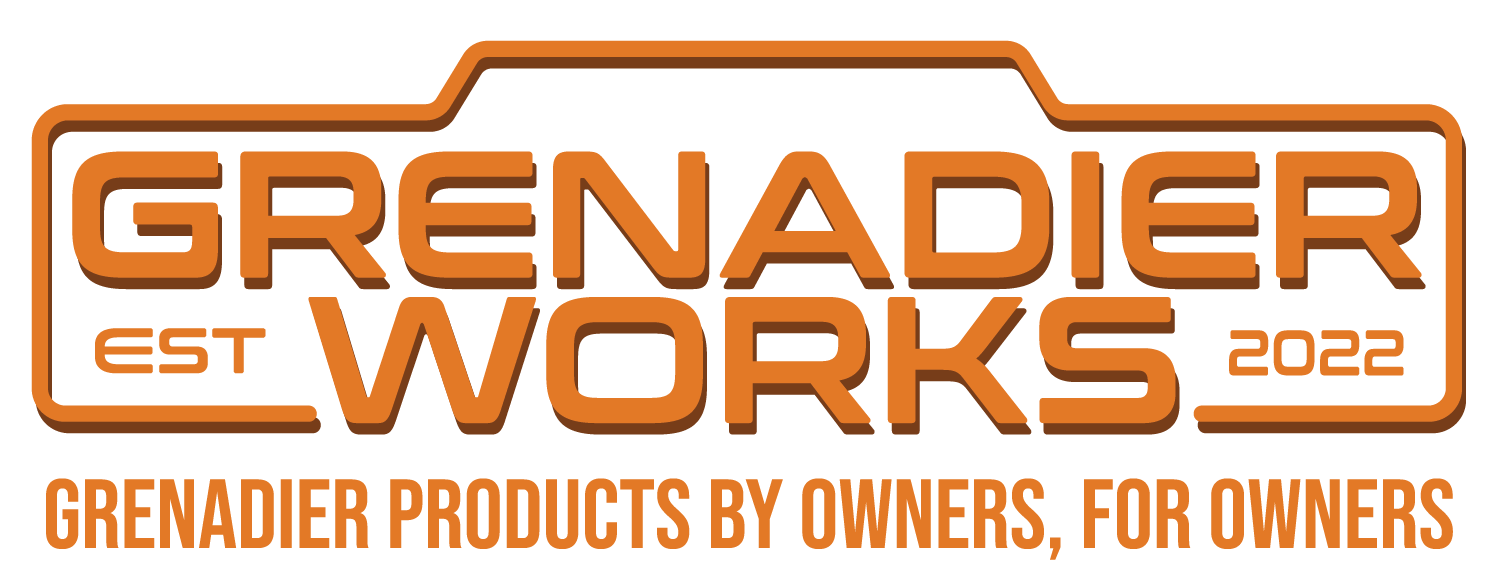The Grenadier Forum
Register a free account today to become a member! Once signed in, you'll be able to contribute to the community by adding your own topics, posts, and connect with other members through your own private inbox! INEOS Agents, Dealers or Commercial vendors please contact admin@theineosforum.com for a commercial account.
You are using an out of date browser. It may not display this or other websites correctly.
You should upgrade or use an alternative browser.
You should upgrade or use an alternative browser.
yeah, that's just parts, labor, I feel, was ....... anyway, It's on the road again and I love it! now to get the lift springs removed.
Looking at your pic makes me think the clamp will tear the boot with just a little more droop.
Could happen on non-lifted vehicles as well.
that's what I'm thinking. waiting to hear back from Eibach. had to send them pics and measurements.Looking at your pic makes me think the clamp will tear the boot with just a little more droop.
Could happen on non-lifted vehicles as well.
There doesn’t seem to be any room for movement on your prop shaft as it’s at quite an extreme angle already , this before you even go off road. I wonder why this is all coming to light now when Eibach have been prototyping these lift springs for quite a while I guess. And Ineos themselves at Kavango has that safari prototype with raised suspension and 34”tyres I wonder what they have experienced or even changed with drive shafts.that's what I'm thinking. waiting to hear back from Eibach. had to send them pics and measurements.
Last edited:
Question: Was this picture taken while the vehicle was on a lift, i.e. the axles hanging free? Or the vehicle sitting on its wheels? There doesn't seem too much clearance between the clip on the shaft and the collar...yeah, that's just parts, labor, I feel, was ....... anyway, It's on the road again and I love it! now to get the lift springs removed.
I'm asking because I discovered today on my vehicle that the metal collar of the boots on my front drive shaft seems to have been treated badly. It's not round any more and has dents.
Just recognized this on a short check before going on a ~800km trip this morning. Can't tell if this was present from the beginning. Pictures follow when I'm back home. Vehicle has no lift and is stock config.
Would it eventually be possible to damage the boot with the axle fully articulated down? And thereby putting a force on the CVs circlip that would make it come out of its seating position?
on level ground. I also fitted a piece of cardboard between the cross member and the shaft, then marked the clearance between the cv joint inner ring. ~3/8 "(9.5mm). Then , from another suggestion, installed an angle finder app on my phone. results = -9.4 degreesQuestion: Was this picture taken while the vehicle was on a lift, i.e. the axles hanging free? Or the vehicle sitting on its wheels? There doesn't seem too much clearance between the clip on the shaft and the collar...
I'm asking because I discovered today on my vehicle that the metal collar of the boots on my front drive shaft seems to have been treated badly. It's not round any more and has dents.
Just recognized this on a short check before going on a ~800km trip this morning. Can't tell if this was present from the beginning. Pictures follow when I'm back home. Vehicle has no lift and is stock config.
Would it eventually be possible to damage the boot with the axle fully articulated down? And thereby putting a force on the CVs circlip that would make it come out of its seating position?
I also fitted a piece of cardboard between the cross member and the shaft, then marked the clearance between the BOTTOM OF THE cv joint inner ring AND THE SHAFT. ~3/8 "(9.5mm)on level ground. I also fitted a piece of cardboard between the cross member and the shaft, then marked the clearance between the cv joint inner ring. ~3/8 "(9.5mm). Then , from another suggestion, installed an angle finder app on my phone. results = -9.4 degrees
I also fitted a piece of cardboard between the cross member and the shaft, then marked the clearance between the BOTTOM OF THE cv joint inner ring AND THE SHAFT. ~3/8 "(9.5mm)
If the front shaft's pivot point is inboard of the CV inner ring (if i'm understanding the terminology) then just a few of inches of downward suspension travel at the diff could lead to interference/binding.
Floor Jack and ramps assisted full articulation on a brand new 2024 bone stock unit.
I definitely will forgo any spring lift and shock modifications until the driveshaft questions are thoroughly ironed out.
Hope these pics are helpful
I definitely will forgo any spring lift and shock modifications until the driveshaft questions are thoroughly ironed out.
Hope these pics are helpful
Attachments
Nice work. The props do look to have very little room left for manoeuvre!Floor Jack and ramps assisted full articulation on a brand new 2024 bone stock unit.
I definitely will forgo any spring lift and shock modifications until the driveshaft questions are thoroughly ironed out.
Hope these pics are helpful
Tks posting. No lift for me until this issue has been ironed out.
I measured the angle between the driveshaft and pinion on mine with no lift, and it was a bit under 10 degrees. I used the face of the bolts to measure the pinion angle, so not super accurate but close enough. The angle is high because the pinion is pointed down, I assume so that it’s parallel with the transfer case which sits higher at the front. This makes sense for a standard two u-joint shaft, but I wonder why Ineos chose to do this with two CV joints. The angle would be less severe with the pinion pointing up towards the transfer case. My old D2 was like this, but it has a double cardan shaft.
The pinion is pointed down as the axle is rotated backwards in order to keep the caster angles within spec. What really needs to happen to help fight against all these driveshaft issues, especially on lifted vehicles, is a redesign of the entire front axle so the pinion angle is much higher and pointing more directly at the transfer case output flange easing the angle of the entire front driveshaft. To do that will require more engineering work from Carraro and Magna and all sorts of analysis for things like caster angles, change in angles as the axle goes through it’s travel, lubrication concerns for pinion running at a higher angle, etc…
The only way to raise the pinion that high without disturbing caster angles is to reengineer the front axle so the kingpin/steering knuckle angles are greater keeping the caster in spec at the higher pinion angle. No adjustable bushings or fancy control arms will fix this as it’s the hard fixed relationship between the kingpin axis and pinion angle because the axle is one solid manufactured component.
On old Land Rovers you could clock or purchase caster corrected swivel housings that would allow you to change the relationship between caster and pinion angles. It was always a black art to get the front caster right and pinion straight enough so the driveshaft angles were less and would run smoother. The Grenadier has fixed positioned kingpins/steering knuckles so the only way to fix this is for a redesigned front axle engineered for less severe driveline angles with steering knuckles that maintain the caster needed for stable steering. I don’t see that happening so for folks wanting big lifts and huge tires it’s always going to be a compromise between capability and reliability which has always been the case with off-roaders.
Who wants to go first with a cut and turn on the axle housing?The pinion is pointed down as the axle is rotated backwards in order to keep the caster angles within spec. What really needs to happen to help fight against all these driveshaft issues, especially on lifted vehicles, is a redesign of the entire front axle so the pinion angle is much higher and pointing more directly at the transfer case output flange easing the angle of the entire front driveshaft. To do that will require more engineering work from Carraro and Magna and all sorts of analysis for things like caster angles, change in angles as the axle goes through it’s travel, lubrication concerns for pinion running at a higher angle, etc…
The only way to raise the pinion that high without disturbing caster angles is to reengineer the front axle so the kingpin/steering knuckle angles are greater keeping the caster in spec at the higher pinion angle. No adjustable bushings or fancy control arms will fix this as it’s the hard fixed relationship between the kingpin axis and pinion angle because the axle is one solid manufactured component.
On old Land Rovers you could clock or purchase caster corrected swivel housings that would allow you to change the relationship between caster and pinion angles. It was always a black art to get the front caster right and pinion straight enough so the driveshaft angles were less and would run smoother. The Grenadier has fixed positioned kingpins/steering knuckles so the only way to fix this is for a redesigned front axle engineered for less severe driveline angles with steering knuckles that maintain the caster needed for stable steering. I don’t see that happening so for folks wanting big lifts and huge tires it’s always going to be a compromise between capability and reliability which has always been the case with off-roaders.
cv's look about the same as mine with the lift
Floor Jack and ramps assisted full articulation on a brand new 2024 bone stock unit.
I definitely will forgo any spring lift and shock modifications until the driveshaft questions are thoroughly ironed out.
Hope these pics are helpful
Attachments
In other words run 33" or 34" tires with zero lift or minimal lift using the Euro spec 30mm Eibach springs. If you need even bigger tires then buy a Jeep. The Grenadier was designed as an overland style rig from the start, optimized for moderate terrain over long distances while carrying significant payload. Tires larger than 34" are not needed for this design brief. Conversely a Jeep Wrangler was designed for technical terrain and easy fitment of the 35" and 37" tires that are a necessity for rock crawling. Pick the right tool for the job.The pinion is pointed down as the axle is rotated backwards in order to keep the caster angles within spec. What really needs to happen to help fight against all these driveshaft issues, especially on lifted vehicles, is a redesign of the entire front axle so the pinion angle is much higher and pointing more directly at the transfer case output flange easing the angle of the entire front driveshaft. To do that will require more engineering work from Carraro and Magna and all sorts of analysis for things like caster angles, change in angles as the axle goes through it’s travel, lubrication concerns for pinion running at a higher angle, etc…
The only way to raise the pinion that high without disturbing caster angles is to reengineer the front axle so the kingpin/steering knuckle angles are greater keeping the caster in spec at the higher pinion angle. No adjustable bushings or fancy control arms will fix this as it’s the hard fixed relationship between the kingpin axis and pinion angle because the axle is one solid manufactured component.
On old Land Rovers you could clock or purchase caster corrected swivel housings that would allow you to change the relationship between caster and pinion angles. It was always a black art to get the front caster right and pinion straight enough so the driveshaft angles were less and would run smoother. The Grenadier has fixed positioned kingpins/steering knuckles so the only way to fix this is for a redesigned front axle engineered for less severe driveline angles with steering knuckles that maintain the caster needed for stable steering. I don’t see that happening so for folks wanting big lifts and huge tires it’s always going to be a compromise between capability and reliability which has always been the case with off-roaders.
Exactly… keep it as close to stock as possible for reliability. A bit larger size tires shouldn’t present a problem if they don’t rub but I don’t think I’d even do the 30mm springs either but that’s just me. Your point is absolutely valid as these vehicles are engineered very well for the parameters they were designed to work within. Beyond stock is always going to be a compromise in reliability and driving quality on the road.In other words run 33" or 34" tires with zero lift or minimal lift using the Euro spec 30mm Eibach springs. If you need even bigger tires then buy a Jeep. The Grenadier was designed as an overland style rig from the start, optimized for moderate terrain over long distances while carrying significant payload. Tires larger than 34" are not needed for this design brief. Conversely a Jeep Wrangler was designed for technical terrain and easy fitment of the 35" and 37" tires that are a necessity for rock crawling. Pick the right tool for the job.
I live in a state in the US where if you are not bouncing your 4x4 off of giant rock boulders or slithering up nearly vertical giant slabs of stone you are laughed at, and your manhood questioned, so I understand the temptation to create a monster Jeep out of the Grenadier but honestly the entire package was engineered for long distance Overlanding which is a different type of mission. Everyone is free to do what they want with their rigs but identify your “real” mission for the vehicle and build it accordingly but you have to be comfortable with the issues that will bring over the long term as it’s all a balance.
Don’t want to burst any other bubbles but for folks thinking they can solve all this with a fancy double/double cardan u-joint driveshafts the answer is maybe. I’d doubt you be able to get an entire new custom assembly to run as smooth as stock especially at highway speeds considering all the adapters and machining/balancing work required to put it all together. If Ineos thought that design would work across the entire spectrum of what the vehicle was designed for it would already be on the vehicle. You’d be chasing harmonic resonating noises and vibrations forever. But that said, it could prove more robust for more extreme off-road terrain but again there is your compromise.
A double/double cardan shaft is very likely stronger, but even with good operating angles (which may not be possible on the Grenadier) they never run as smoothly as a true rzeppa style CV shaft. I have first hand experience as my Jeep Wrangler has a double cardan shaft front and rear and at certain speeds it has proven impossible to completely eliminate harmonic vibrations. Most Jeep owners accept this as a fair trade off given the technical capability on tap. But the Grenadier is much more refined both on and off road and few owers are likely to find the vibrations tolerable.Don’t want to burst any other bubbles but for folks thinking they can solve all this with a fancy double/double cardan u-joint driveshafts the answer is maybe. I’d doubt you be able to get an entire new custom assembly to run as smooth as stock especially at highway speeds considering all the adapters and machining/balancing work required to put it all together. If Ineos thought that design would work across the entire spectrum of what the vehicle was designed for it would already be on the vehicle. You’d be chasing harmonic resonating noises and vibrations forever. But that said, it could prove more robust for more extreme off-road terrain but again there is your compromise.
The pinion is pointed down as the axle is rotated backwards in order to keep the caster angles within spec. What really needs to happen to help fight against all these driveshaft issues, especially on lifted vehicles, is a redesign of the entire front axle so the pinion angle is much higher and pointing more directly at the transfer case output flange easing the angle of the entire front driveshaft. To do that will require more engineering work from Carraro and Magna and all sorts of analysis for things like caster angles, change in angles as the axle goes through it’s travel, lubrication concerns for pinion running at a higher angle, etc…
With the small amount of pinion angle correction needed to spare the CV joints I'm wondering why that wasn't built in at the start? Did Carraro have a restriction on the pinion angle? Our vehicle tracks pretty darn well (was driving at 80mph/130kph this afternoon) but our front pinion angle is pointing down enough to be concerning and there's a bit of resonance at higher rpm. I need to inspect the caster bolts to see if the housing has been rotated to provide the better tracking at the expense of the CVs.
A double/double cardan shaft is very likely stronger, but even with good operating angles (which may not be possible on the Grenadier) they never run as smoothly as a true rzeppa style CV shaft. I have first hand experience as my Jeep Wrangler has a double cardan shaft front and rear and at certain speeds it has proven impossible to completely eliminate harmonic vibrations. Most Jeep owners accept this as a fair trade off given the technical capability on tap. But the Grenadier is much more refined both on and off road and few owers are likely to find the vibrations tolerable.
And the Grenadier is a full-time system meaning you're always spinning both the front and rear prop shafts. That's largely an unfamiliar arrangement in the States. Most solid axle vehicles here allow for rear drive only when highway miles are driven. Part-time hides a multitude of problems that the mall-crawling average purchaser will never encounter.
Who wants to go first with a cut and turn on the axle housing?
Ineos' concern is whether or not unlifted vehicles are exhibiting issues in number. If so and this isn't addressed/resolved during the warranty period then a cut and turn may become de rigueur to retain any usefulness in these vehicles. Fortunately the Carraro pinion gear does seem long - much longer than a Dana 44. It wouldn't take more than a few degrees of upward rotation to swing the CV up into an acceptable range. At least we don't have to match angles like with universal joints.
With the small amount of pinion angle correction needed to spare the CV joints I'm wondering why that wasn't built in at the start? Did Carraro have a restriction on the pinion angle? Our vehicle tracks pretty darn well (was driving at 80mph/130kph this afternoon) but our front pinion angle is pointing down enough to be concerning and there's a bit of resonance at higher rpm. I need to inspect the caster bolts to see if the housing has been rotated to provide the better tracking at the expense of the CVs.
And the Grenadier is a full-time system meaning you're always spinning both the front and rear prop shafts. That's largely an unfamiliar arrangement in the States. Most solid axle vehicles here allow for rear drive only when highway miles are driven. Part-time hides a multitude of problems that the mall-crawling average purchaser will never encounter.
Ineos' concern is whether or not unlifted vehicles are exhibiting issues in number. If so and this isn't addressed/resolved during the warranty period then a cut and turn may become de rigueur to retain any usefulness in these vehicles. Fortunately the Carraro pinion gear does seem long - much longer than a Dana 44. It wouldn't take more than a few degrees of upward rotation to swing the CV up into an acceptable range. At least we don't have to match angles like with universal joints.
One consideration on how far they can pivot the pinion up probably has to do with the clearance between the diff/pinion and oil sump. If you look under your vehicle even in its stock configuration and imagine the axle articulating upwards the pinion housing and driveshaft gets very close to those components. My guess is this is a limitation on how far they could ultimately tilt it up so very much a packaging consideration for leaving enough space for full axle articulation.
To my mind the only modification, if you absolutely must have a lift over stock height, would be to get custom driveshaft with “high” angle larger Rzeppa joints. It would be a cobbled together deal with custom parts but at least you’d still be running a CV style joint hopefully preserving the smoother ride. You’d have all the same concerns of caster adjustments and don’t forget all the driveshaft angles on the Grenadier are compound angles so both vertical and horizontal. None of the pinions and output shafts line up in a straight line hence why they chose Rzeppa joints in the first place.
All the larger high angle Rzeppa joints would gain you would be a bit more time between a driveshaft overhauls and just thinking about all that work and expense says remaining stock is best option and use the vehicle within it’s factory designed limits which honestly is still plenty of fun to be had.
Last edited:
Similar threads
- Replies
- 99
- Views
- 3K
- Replies
- 23
- Views
- 1K
- Replies
- 3
- Views
- 320
- Replies
- 8
- Views
- 375
